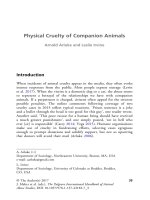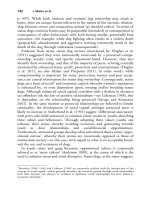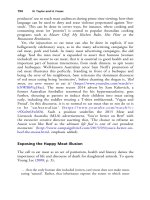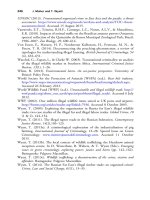The palgrave international handbook of a 265
Bạn đang xem bản rút gọn của tài liệu. Xem và tải ngay bản đầy đủ của tài liệu tại đây (27.62 KB, 1 trang )
Animal Abuse Resulting from Wildlife Habitat Destruction
261
continuous living in nature by humans (Merchant 2005; Plumwood 2004;
Tsing 2005), including within the most inhospitable environments possible
from a human perspective (Robyn 2002).
Second, the notion of ‘pristine nature’ implies immutable or unchanging
conditions. Yet, nature is inherently changeable. If we re-cast the issue into
the language of ‘harm’, then it becomes even more complicated. To protect
against intrinsic harm to the environment requires an understanding of what
the environment is and how it can be harmed. If ‘environment’ refers to the
natural world, and if the source of value in the natural world is its selfmaintaining sustaining properties, then harm to the environment involves
setbacks to these self-maintaining properties. Harm to the environment, in
other words, might be defined as a change from the environment’s ‘natural’,
self-maintaining state. The problem with this view is that the environment is
not in static equilibrium; rather, it is a dynamic entity undergoing constant
change. Preserving the environment in its natural state is likely an impossible,
and perhaps undesirable, mission (Lin 2006, p. 981).
So, too, when it comes to the relationship between particular kinds of
habitat and particular species of animal difficult choices frequently present
themselves. For instance, debates presently occur over which animals are
valued over others when it comes to survival dilemmas. Human intervention
in the lives of both wild and domesticated animals has major ramifications for
species survival and biodiversity. Consider, for example, the phenomenon of
assisted colonisation, which involves the moving of species to sites where they
do not currently occur or have not been known to occur in recent history. This
is happening in response to climate change, and usually is directed at species in
the wild. ‘In the UK, two native species of butterfly were recently translocated
approximately 65 km northward into areas identified by modelling as climatically suitable for occupancy by the butterflies’ (Sutherland et al. 2009).
The problem is that non-native species moving into new ecosystems are
already recognised as a major conservation problem (see Secretariat of the
Convention on Biological Diversity 2010). This is evidenced, for example,
by the rapid expansion in the numbers of Indo-Pacific lionfish along the east
coast of the USA and in the Caribbean to the detriment of native coral reef
fish (Sutherland et al. 2009). Assisted colonists could be viewed as invasive
and as constituting a potential danger to existing ecosystems and their
inhabitants. Classic cases where considerable damage has resulted include
the introduction of the cane toad into Australia. Its subsequent spread has
had colossal impacts on native species. With no or few natural predators, it
has proliferated and continues to take over more and more territories previously held by other endemic species.









